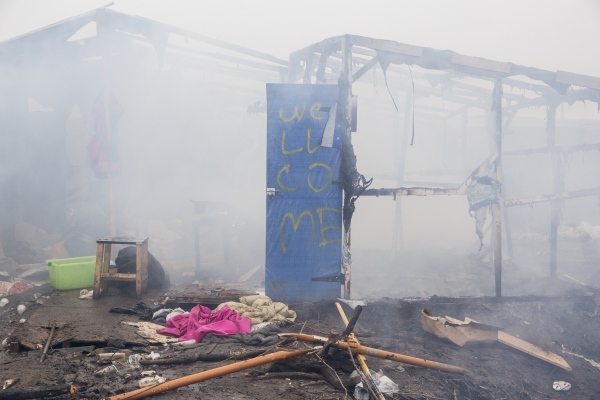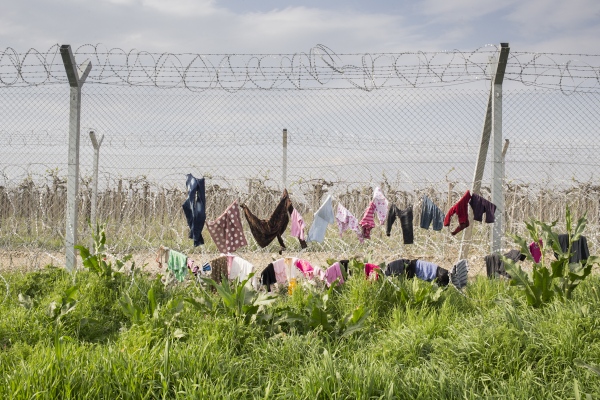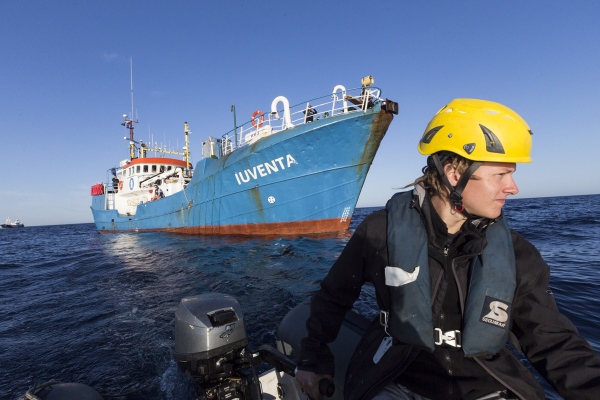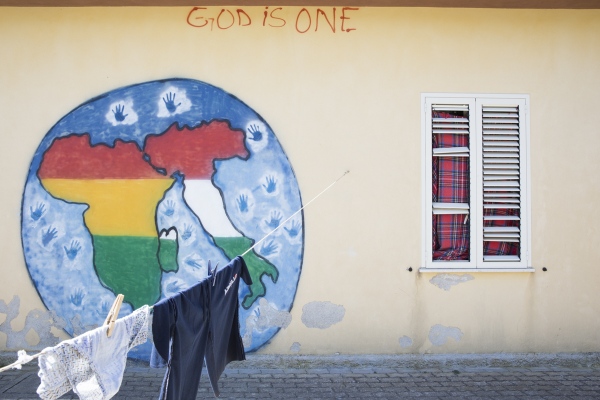
WELCOME TO THE JUNGLE (CALAIS REFUGEE CAMP)
Here we are, three weeks after the prefect Fabienne Buccio ordered the dismantling of the southern area of the so called “Calais Jungleâ€. Despite the protests, demolition teams protected by some RSC’s (Republican Security Companies) have embarked on the systematic destruction of the camp.
All its southern part was razed and other infrastructures should be demolished shortly.
Only few buildings will remain in place: the school, the theatre and the places of worship.
In a few days, the dramatic situation that refugees were already facing has got even worse, when they lost the little they had to survive: a shelter to protect themselves from cold, precarious accomodation to sleep. Nonetheless, migrants keep faith and are working in cooperation with many activists and volunteers by moving their shacks to the northern area of the camp, which hasn’t been demolished yet and is considered safe for families with children.
Refugees that decided to apply for asylum in France were guaranteed to be rehoused in a camp within containers surrounded by barbed wire and CCTV cameras. In order to access this camp, it is necessary that refugees own a secret code and have their fingerprints recorded. However, many refugees connect this kind of camp to a prison and refuse to go there. They prefer staying in the “Calais Jungleâ€, in spite of the deplorable living conditions.
All its southern part was razed and other infrastructures should be demolished shortly.
Only few buildings will remain in place: the school, the theatre and the places of worship.
In a few days, the dramatic situation that refugees were already facing has got even worse, when they lost the little they had to survive: a shelter to protect themselves from cold, precarious accomodation to sleep. Nonetheless, migrants keep faith and are working in cooperation with many activists and volunteers by moving their shacks to the northern area of the camp, which hasn’t been demolished yet and is considered safe for families with children.
Refugees that decided to apply for asylum in France were guaranteed to be rehoused in a camp within containers surrounded by barbed wire and CCTV cameras. In order to access this camp, it is necessary that refugees own a secret code and have their fingerprints recorded. However, many refugees connect this kind of camp to a prison and refuse to go there. They prefer staying in the “Calais Jungleâ€, in spite of the deplorable living conditions.

IDOMENI'S LIMBO
While the EU is spending millions of euros on repression and emargination policies thinking to solve the issue by building new walls and barriers, life in Idomeni goes on. Days become months and – who knows? – years. Pessimism and hatred are increasing, desperation, frustration and tension are prevailing, hence episodes of internal violence, as well as clashes with the police patrolling the borders that happen almost every day.
What will be the fate of people who are only guilty of escaping from war and violence?
It is quite understandable that these people do not want to go back to their countries after paying a fortune to reach Europe. For them, this long, tough journey will only be over once they will have reached a place where to live under respectable conditions and build a future for themselves and their beloved ones.
“How long can you stand living here?†– I asked a Syrian refugee that accepted to be photographed and tell his story.
“I survived the bombs, I lost a brother and other relatives, my house does not exist any longer. I can resist in this situation still a few more weeks hoping that the EU will reopen the borders, otherwise I will have to find another solution… I dream of the day when I will finally be able to go back to my country but until then, I will keep fighting in hopes of seeing my dream come true.â€
What will be the fate of people who are only guilty of escaping from war and violence?
It is quite understandable that these people do not want to go back to their countries after paying a fortune to reach Europe. For them, this long, tough journey will only be over once they will have reached a place where to live under respectable conditions and build a future for themselves and their beloved ones.
“How long can you stand living here?†– I asked a Syrian refugee that accepted to be photographed and tell his story.
“I survived the bombs, I lost a brother and other relatives, my house does not exist any longer. I can resist in this situation still a few more weeks hoping that the EU will reopen the borders, otherwise I will have to find another solution… I dream of the day when I will finally be able to go back to my country but until then, I will keep fighting in hopes of seeing my dream come true.â€

IUVENTA RESCUE
With the arrival of the vessel Iuventa - belonging to the NGO "Jugend Rettet" - the humanitarian emergency in the Mediterranean sea changes its route. This ship represents a Europe quite different from the one gravitating around Bruxelles bureaucracy and banks' interests: it's the fresh, energetic face of Europe. young men and women born and raised in the dynamic Berlin, all aged between 20 and 40, with clear ideas, different work ethic and a bunch of life jackets ready at hand.
The NGO they work for is German, but the boat sports the flag of The Netherlands: no problem for them, as their goal is just to do their best to ensure safe operations when migrants from Africa leave those infamous boats filled with desperation. The ship Iuventa has been sailing since July 26th, 2016, but it started to navigate the web well before this date, funding its own project through a crowdfunding platform.
The project worked fine: 300,000 Euros were collected, and it took just two months in Venice, in the shipyard of the Faldis Group, to transform a ship - close to be demolished - into a state-of-the-art standby safety vessel. Today over the worn out helm there are computers and modern electronic tools, while old sailors stand side by side with tattooed, digital youngsters.
This is no more the Europe of Christopher Columbus or Vasco da Gama. ItÂ’s the one belonging to a new generation that wants to trace different routes on the map: the routes of the future society.
The NGO they work for is German, but the boat sports the flag of The Netherlands: no problem for them, as their goal is just to do their best to ensure safe operations when migrants from Africa leave those infamous boats filled with desperation. The ship Iuventa has been sailing since July 26th, 2016, but it started to navigate the web well before this date, funding its own project through a crowdfunding platform.
The project worked fine: 300,000 Euros were collected, and it took just two months in Venice, in the shipyard of the Faldis Group, to transform a ship - close to be demolished - into a state-of-the-art standby safety vessel. Today over the worn out helm there are computers and modern electronic tools, while old sailors stand side by side with tattooed, digital youngsters.
This is no more the Europe of Christopher Columbus or Vasco da Gama. ItÂ’s the one belonging to a new generation that wants to trace different routes on the map: the routes of the future society.

RIACE AND THE LOCRIDE: A TRAVEL THROUGH RECEPTION AND UTOPIA
In the last few years, in the Ionian zone of the Province of Reggio Calabria, known as Locride, five small villages, such as Caulonia, Stignano, Monasterace and Badolato, along with Riace itself (the first case), have become successful models of integration offering immigrants arriving from across the sea a warm welcome along with homes in a number of empty buildings in the historic centre. These experiences are based on an experiment of territorial development through the rebirth of rural economies in Southern Italy that had almost disappeared. This way, migration is providing a new lease of life to rural villages abandoned over the last two centuries that have now been repopulated and can be lively communities once again. Starting from this assumption, the five Italian villages that risked becoming “ghost towns†because of the emigration of most part of their population to the USA, Northern Italy and the rest of Europe, are now experimenting long-term strategies and policies regarding migration, seeing migration itself as a positive factor enhancing the whole society economically, socially and culturally.
